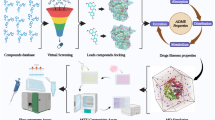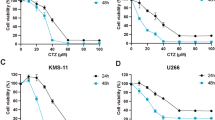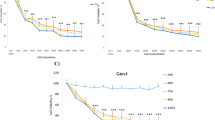Abstract
Aim:
To explore the mechanisms underlying the oridonin-induced apoptosis and autophagy in human multiple myeloma cells in vitro.
Methods:
Human multiple myeloma RPMI8266 cells were used. The cell viability was assessed using MTT assay. Morphological changes of apoptosis and autophagy were observed under transmission electron microscope. TUNEL and annexin V-FITC/PI dual staining assays were used to measure apoptosis. Autophagy was analyzed using Western blot analysis and immunofluorescence staining with a QDs605 nm-Anti-LC3 fluorescent probe. Intracellular ROS was estimated with flow cytometry using DCFH-DA fluorescent probe. Protein levels of active caspase 3, Beclin 1 and SIRT1 were determined with Western blot analysis.
Results:
Exposure to oridonin (1-64 μmol/L) inhibited the proliferation of RPMI8266 cells in a concentration-dependent manner with an IC50 value of 6.74 μmol/L. Exposure to oridonin (7 μmol/L) simultaneously induced caspase 3-mediated apoptosis and Beclin 1-dependent autophagy of RPMI8266 cells. Both the apoptosis and autophagy were time-dependent, and apoptosis was the main effector pathway of cell death. Exposure to oridonin (7 μmol/L) increased intracellular ROS and reduced SIRT1 nuclear protein in a time-dependent manner. The blockade of intracellular generation of ROS by NAC (5 mmol/L) abrogated apoptosis, autophagy and the decrease of SIRT1 in the cells exposed to oridonin (7 μmol/L). The inhibition of autophagy by 3-MA (5 mmol/L) sensitized the cells to oridonin-induced apoptosis, which was accompanied by increased intracellular ROS and decreased SIRT1.
Conclusion:
Oridonin simultaneously induces apoptosis and autophagy of human multiple myeloma RPMI8266 cells via regulation of intracellular ROS generation and SIRT1 nuclear protein. The cytotoxicity of oridonin is mainly mediated through the apoptotic pathway, whereas the autophagy protects the cells from apoptosis.
Similar content being viewed by others
Log in or create a free account to read this content
Gain free access to this article, as well as selected content from this journal and more on nature.com
or
References
Ikezoe T, Chen SS, Tong XJ, Heber D, Taguchi H, Koeffler HP . Oridonin induces growth inhibition and apoptosis of a variety of human cancer cells. Int J Oncol 2003; 23: 1187–93.
Osawa K, Yasuda H, Maruyama T, Morita H, Takeya K, Itokawa H . Antibacterial trichorabdal diterpenes from Rabdosia trichocarpa. Phytochemistry 1994; 36: 1287–91.
Han QB, Li ML, Li SH, Mou YK, Lin ZW, Sun HD . Ent-kaurane diterpenoids from Isodon rubescens var lushanensis. Chem Pharm Bull (Tokyo) 2003; 51: 790–3.
Bursch W, Ellinger A, Gerner C, Frohwein U, Schulte-Hermann R . Programmed cell death (PCD). Apoptosis, autophagic PCD, or others? Ann N Y Acad Sci 2000; 926: 1–12.
Shintani T, Klionsky DJ . Autophagy in health and disease: a double-edged sword. Science 2004; 306: 990–5.
Tsujimoto Y, Shimizu S . Another way to die: autophagic programmed cell death. Cell Death Differ 2005; 12: 1528–34.
Yang ZJ, Chee CE, Huang S, Sinicrope FA . The role of autophagy in cancer: therapeutic implications. Mol Cancer Ther 2011; 10: 1533–41.
Cui Q, Tashiro S, Onodera S, Minami M, Ikejima T . Oridonin induced autophagy in human cervical carcinoma HeLa cells through Ras, JNK, and P38 regulation. J Pharmacol Sci 2007; 105: 317–25.
Li D, Cui Q, Chen SG, Wu LJ, Tashiro S, Onodera S, et al. Inactivation of ras and changes of mitochondrial membrane potential contribute to oridonin-induced autophagy in a431 cells. J Pharmacol Sci 2007; 105: 22–33.
Cheng Y, Qiu F, Huang J, Tashiro S, Onodera S, Ikejima T . Apoptosis-suppressing and autophagy-promoting effects of calpain on oridonin-induced L929 cell death. Arch Biochem Biophys 2008; 475: 148–55.
Hoang B, Benavides A, Shi Y, Frost P, Lichtenstein A . Effect of autophagy on multiple myeloma cell viability. Mol Cancer Ther 2009; 8: 1974–84.
Hou DX, Tong X, Terahara N, Luo D, Fujii M . Delphinidin 3-sambubioside, a Hibiscus anthocyanin, induces apoptosis in human leukemia cells through reactive oxygen species-mediated mitochondrial pathway. Arch Biochem Biophys 2005; 440: 101–9.
Chipuk JE, Bouchier-Hayes L, Green DR . Mitochondrial outer membrane permeabilization during apoptosis: the innocent bystander scenario. Cell Death Differ 2006; 13: 1396–402.
Lisanti MP, Martinez-Outschoorn UE, Chiavarina B, Pavlides S, Whitaker-Menezes D, Tsirigos A, et al. Understanding the “lethal” drivers of tumor-stroma co-evolution: emerging role(s) for hypoxia, oxidative stress and autophagy/mitophagy in the tumor micro-environment. Cancer Biol Ther 2010; 10: 537–42.
Essick EE, Sam F . Oxidative stress and autophagy in cardiac disease, neurological disorders, aging and cancer. Oxid Med Cell Longev 2010; 3: 168–77.
Scherz-Shouval R, Elazar Z . Regulation of autophagy by ROS: physiology and pathology. Trends Biochem Sci 2011; 36: 30–8.
Grimsrud PA, Xie H, Griffin TJ, Bernlohr DA . Oxidative stress and covalent modification of protein with bioactive aldehydes. J Biol Chem 2008; 283: 21837–41.
Hasegawa K, Wakino S, Yoshioka K, Tatematsu S, Hara Y, Minakuchi H, et al. Sirt1 protects against oxidative stress-induced renal tubular cell apoptosis by the bidirectional regulation of catalase expression. Biochem Biophys Res Commun 2008; 372: 51–6.
Caito S, Hwang JW, Chung S, Yao H, Sundar IK, Rahman I . PARP-1 inhibition does not restore oxidant-mediated reduction in SIRT1 activity. Biochem Biophys Res Commun 2010; 392: 264–70.
Ford J, Jiang M, Milner J . Cancer-specific functions of SIRT1 enable human epithelial cancer cell growth and survival. Cancer Res 2005; 65: 10457–63.
Kojima K, Ohhashi R, Fujita Y, Hamada N, Akao Y, Nozawa Y, et al. A role for SIRT1 in cell growth and chemoresistance in prostate cancer PC3 and DU145 cells. Biochem Biophys Res Commun 2008; 373: 423–8.
Hwang JW, Chung S, Sundar IK, Yao H, Arunachalam G, McBurney MW, et al. Cigarette smoke-induced autophagy is regulated by SIRT1-PARP-1-dependent mechanism: implication in pathogenesis of COPD. Arch Biochem Biophys 2010; 500: 203–9.
Chung S, Yao H, Caito S, Hwang JW, Arunachalam G, Rahman I . Regulation of SIRT1 in cellular functions: role of polyphenols. Arch Biochem Biophys 2010; 501: 79–90.
Xie HY, Liang JG, Liu Y, Zhang ZL, Pang DW, He ZK, et al. Preparation and characterization of overcoated II–VI quantum dots. J Nanosci Nanotechnol 2005; 5: 880–6.
Kabeya Y, Mizushima N, Ueno T, Yamamoto A, Kirisako T, Noda T, et al. LC3, a mammalian homologue of yeast Apg8p, is localized in autophagosome membranes after processing. EMBO J 2000; 19: 5720–8.
Cui Q, Tashiro S, Onodera S, Ikejima T . Augmentation of oridonin-induced apoptosis observed with reduced autophagy. J Pharmacol Sci 2006; 101: 230–9.
Jia L, Dourmashkin RR, Allen PD, Gray AB, Newland AC, Kelsey SM . Inhibition of autophagy abrogates tumour necrosis factor alpha induced apoptosis in human T-lymphoblastic leukaemic cells. Br J Haematol 1997; 98: 673–85.
Zhu JH, Horbinski C, Guo F, Watkins S, Uchiyama Y, Chu CT . Regulation of autophagy by extracellular signal-regulated protein kinases during 1-methyl-4-phenylpyridinium-induced cell death. Am J Pathol 2007; 170: 75–86.
Chen Y, McMillan-Ward E, Kong J, Israels SJ, Gibson SB . Oxidative stress induces autophagic cell death independent of apoptosis in transformed and cancer cells. Cell Death Differ 2008; 15: 171–82.
Yang SR, Wright J, Bauter M, Seweryniak K, Kode A, Rahman I . Sirtuin regulates cigarette smoke-induced proinflammatory mediator release via RelA/p65 NF-kappaB in macrophages in vitro and in rat lungs in vivo: implications for chronic inflammation and aging. Am J Physiol Lung Cell Mol Physiol 2007; 292: L567–76.
Rajendrasozhan S, Yang SR, Kinnula VL, Rahman I . SIRT1, an antiinflammatory and antiaging protein, is decreased in lungs of patients with chronic obstructive pulmonary disease. Am J Respir Crit Care Med 2008; 177: 861–70.
Kim EJ, Um SJ . SIRT1: roles in aging and cancer. BMB Rep 2008; 41: 751–6.
Acknowledgements
This work was supported by grants from the National Natural Science Foundation of China (No 30871036 and 81070429).
Author information
Authors and Affiliations
Corresponding author
Rights and permissions
About this article
Cite this article
Zeng, R., Chen, Y., Zhao, S. et al. Autophagy counteracts apoptosis in human multiple myeloma cells exposed to oridonin in vitro via regulating intracellular ROS and SIRT1. Acta Pharmacol Sin 33, 91–100 (2012). https://doi.org/10.1038/aps.2011.143
Received:
Accepted:
Published:
Issue date:
DOI: https://doi.org/10.1038/aps.2011.143
Keywords
This article is cited by
-
Different types of cell death and their shift in shaping disease
Cell Death Discovery (2023)
-
Terpenoids’ anti-cancer effects: focus on autophagy
Apoptosis (2021)
-
Naturally occurring anti-cancer compounds: shining from Chinese herbal medicine
Chinese Medicine (2019)
-
Inhibition of SIRT1/2 upregulates HSPA5 acetylation and induces pro-survival autophagy via ATF4-DDIT4-mTORC1 axis in human lung cancer cells
Apoptosis (2019)
-
Molecular mechanisms of apoptosis and autophagy elicited by combined treatment with oridonin and cetuximab in laryngeal squamous cell carcinoma
Apoptosis (2019)



